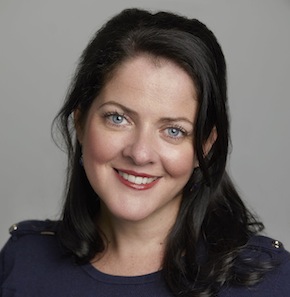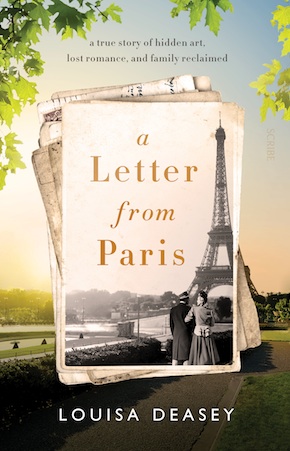Great expectations untold
by Mika Provata-CarloneIn 1949 an Australian man is travelling around Europe – a Europe that has only recently emerged from the cataclysmic shock of WWII, and still very much bears the marks of unhealed, perhaps unhealable searing wounds. This man, Denison Deasey, carries with him an aura of mystery and of multiform tragedy, of fate eluded and of destiny pursued. He is a bohemian, a migratory bird undeterred by storms or changing winds. He meets some of the most prominent figures in art and literature at the time, in Paris and in London, forms attachments with two French women whose lives he will define and determine till the end of their days. He appears as a luminous figure out of the mists of time, promising stories, solutions to riddles, vital lifelines for those he has left behind.
Almost 70 years later, his youngest daughter Louisa decides to retrace his steps and to piece his story back together from fragments belonging to an archive of gargantuan proportions and Pickwick-like complexity and disorder. She is a writer, as was her father, a connection that to her becomes a subliminal guide through the chaos of her father’s material and also beyond what is a crisis and a turning point in her own life.
Denison Deasey leads his daughter through a labyrinth of marriages, liaisons, ventures and war experiences. Everything he has to pass on to her possesses the lure and enigma of belonging to a “completely different time”, and it is this time and its mysteries as opposed to a current time that seems to be suspended between an intriguing past and a future of undeveloped possibility that A Letter from Paris seeks to explore and to trace in an explicitly affective and tactile way.
Who owns each successive cycle of family remembrance? What if one’s kith and kin died before or soon after one was born, would one still have a right to their personal and their shared history?”
Denison Deasey was “remarkable” but “wild”, “inexplicable, someone I should perhaps be ashamed of”; he had “lived a life that was far from normal – or even acceptable – to the family and time in which he was born.” According to one of his obituaries, cryptic, unsettling documents filled with many questions and unfinished business, he was “caught somewhere between the Celtic twilight, the south of France and Ayer’s Rock” – the sacred Uluru rock of Indigenous Australians. Louisa Deasey’s parents separated when she was six months old and her father died shortly before her seventh birthday. He is, in her recollection of him, “old, sick, the holder of history from an era I would never really understand.” In the course of this attempt to comprehend and clarify, she will have to confront the questions of failure vs. success, past vs. present, Europe vs. Australia, a creative world vs. a world of socially endorsed professional success and enterprise, free-wheeling vs. conservatism and conformism, a materially carefree affluence (or its semblance) vs. the quotidian logistics of life and Anglo-Saxon (Church of England Anglo-Saxon) austerity and frugality. Especially the question of old rooftops vs. weatherboard houses.
The premise of A Letter from Paris is an interesting one: who owns each successive cycle of family remembrance? What if one’s kith and kin died before or soon after one was born, would one still have a right to their personal and their shared history? To a genealogy of stories and memory? Are there sluices and barriers that control or cut off the flow of the river of time?
The subject matter of Louisa Deasey’s book warrants great and excited expectations: the story of an Australian maverick providing an entirely different prism for late European modernism, for the artistic, sociohistorical and literary anxieties of war-crushed England and France from an Antipodean perspective of both culture and history, perhaps even of humanity. In the course of her sketch of her father, Deasey allows us glimpses of his trajectory and his points of arrival or departure. He was a restless spirit, an aspiring writer, a skilled linguist, with a talent of connecting and with a mind for both feral and fairytale-like projects; he interacted with prominent Australian and European cultural angels or monsters, such as Arthur Boyd, Sidney Nolan, Albert Tucker and the Heide Circle, Alister Kershaw, Louis McNeice, Roy Campbell, Richard Aldington, D.H. Lawrence and Dylan Thomas, even Barry Humphries makes a predictably larger-than-life appearance. Denison Deasey was also a member of a Special Forces unit in the Northern Territory, a story he kept resoundingly and painfully silent.
The journey begins with an intrigue: a Facebook post mentioning letters by a Frenchwoman and concerning Louisa Deasey’s father. It could all have made for a thrilling read.”
Poignant too is the sense of relentless displacement and dispossession that Louisa Deasey must come to terms with: her private memory is constantly unavailable and inaccessible to her, either because she was too young to possess reminiscences of her own, or because others hold the actual physical materials or the keys: her mother (a third woman taking over from the two French ones her father met in 1949) vehemently resists the past as well as the present, and apparently destroys both memory and mementoes, leaving her daughter desperate for more; she has also sold the Denison Deasey papers to the Victoria State Library, where Louisa Deasey must request access, rationed and supervised, to the most intimate and simplest scraps of her own past. The journey begins with an intrigue: a Facebook post mentioning letters by a Frenchwoman and concerning Louisa Deasey’s father. It could all have made for a thrilling read, a fascinating private rite of passage and a public story of so much that still needs to be said.
One cannot fault Deasey’s eagerness to probe and investigate, to complete what she calls her PhD on her father’s life. One would, however, have wished for much greater rigour both in the treatment of her subject and in most of the cultural and psychological analysis, in what concerns the private clarity of focus and intentions, and her sense of public purpose. The emphasis on a self-focus, on a self-portrait of the artist as a young Australian woman, as a maverick without a Melbourne equal, is quite overwhelming, as is the ‘down and out in New York and Paris’ kind of angle that distracts and often distresses her reader. There is too much Facebook, texting, Instagram, Airbnb, Craigslist, TripAdvisor, a clutter of millennial clichés and a vernacular, blog-type style, which removes much substance from her intended narrative.
Post-1950s Melbourne, and Australia in general, England in the aftermath of WWII, receive a very poor treatment in her hands, the first as a hostile, barren place for free thinkers and creative minds, the second as a miserly, ration-pestered nation, unable to see beyond the daily or weekly allowance of butter or eggs. “I realised what a cottage industry the writing profession was in Australia,” she laments, echoing her father’s declaration about “the spiritual poverty of Australia, which was an intellectually and culturally arid wasteland in the 1950s.” She presents us with a very young-of-mind hyperbole and sense of drama, of the loneliness of the ‘I’, a rootlessness and materialism wholly attributed to Australia that she intends to counter with a euphoric adoption scheme: a European home, culture and rather rickety ancestry, a surrogate family to make up for the one she feels she never had. And her Europe is essentially just France – “even the illegal market vendors spruiking rotten bananas near the sex shops by the Moulin Rouge looked glamorous. Dirt was pretty in this city.” Vive la France, even if French gets a dog-Latin treatment throughout (“des les fonds”, “est-ils privée”, apparently said by native French speakers…).
It is a largely missed, great opportunity: Deasey could have given us, through the quieter, more personally revealing story of her father, a mural of Australian culture both at home and in the expat communities abroad that could have had a very unique and enticing flavour. Her father brushed shoulders with Max Harris, John Reed and Geoffrey Dutton of the Angry Penguins, a riotously riveting modernist magazine and movement that became notorious for the Ern Malley Hoax in 1943 – a hoax to beat any mere prank by the French Surrealists, and still occupying considerable academic brain space. She underplays his association with the Heide Circle, an artists’ colony named after John and Sunday Reed’s dairy farm which became their base, now a leading gallery of modern art in Australia, a very dynamic, complex set of personalities and talent. He was one of the research assistants of Richard Aldington, as he was writing his own provocative biography of T.E. Lawrence (she fails to mention that there was a substantial team of nine doing all the digging and footwork on Aldington’s behalf), an experience that left him the owner of a letter by D.H. Lawrence and of original sketches by Tsuguharu Fujita. Each of these connections might have supplied her with the fabric for many engrossing tales which she could have connected fruitfully and excitingly to her own. Beyond what feels like heavily edited/rewritten tatters and snippets of reference to verbalise her father’s own significance, little is made of what could have been a treasure trove. Denison Deasey’s part in WWII could also have been a path for her to follow more closely, an often muted side of the Australian experience of the war with its own tragic wealth of trauma and human pathos.
Deasey tantalisingly reveals to us that she has discovered yet another almost mythic find: her father’s finished manuscript of his travel memoir on France.”
Instead, Louisa Deasey’s mentor, the astrologer Mystic Medusa, gets a somewhat disproportionate tribute and exposure, as do the minutiae of everything that happens during the course of her research and retrieval of the past. So much so that we in fact see very little of what she does discover in the archives, as though the gesture of searching had become a substitute for the object of the search itself. Money, a life of cultured, rather stylised leisure, Instagramable elegance and adventurous insouciance are key concerns, as is, admittedly, the deeply emotional process of re-encountering one’s long lost father.
This could have been quite a marvellous story and adventure, with the benefit of a shrewder authorial perspective and much stricter editing. Deasey tantalisingly reveals to us that she has discovered yet another almost mythic find: her father’s finished manuscript of his travel memoir on France, describing life “with Australian expats and Bohemians who had escaped Melbourne.” One would be inclined to assume that she intends it to be her next publishing foray, and perhaps this is where her father’s throbbing life-story might at last be found: for one thing transpires with certainty from Louisa Deasey’s book – there is a fine story still waiting to be told.
 Louisa Deasey is a Melbourne-based writer who has published widely, including in Overland, Vogue, The Australian, and The Saturday Age. Her first memoir, Love and Other U-Turns, was nominated for the Nita B. Kibble Award for women writers. A Letter from Paris is published in paperback and eBook by Scribe.
Louisa Deasey is a Melbourne-based writer who has published widely, including in Overland, Vogue, The Australian, and The Saturday Age. Her first memoir, Love and Other U-Turns, was nominated for the Nita B. Kibble Award for women writers. A Letter from Paris is published in paperback and eBook by Scribe.
Read more
louisadeasey.com
@louisadeasey
Mika Provata-Carlone is an independent scholar, translator, editor and illustrator, and a contributing editor to Bookanista. She has a doctorate from Princeton University and lives and works in London.


